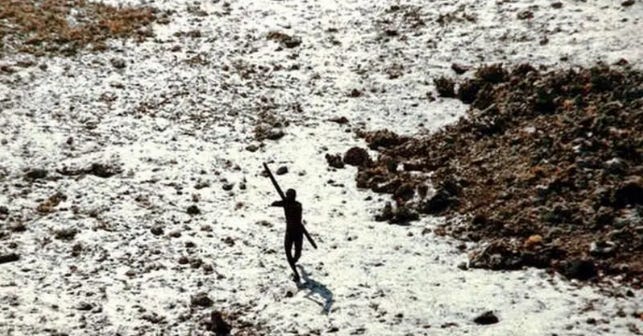A sugary drink isn’t the oddest thing anyone has ever left an ‘uncontacted’ tribe
US citizen's arrest in India is a reminder of other efforts being made to contact indigenous people in "isolation"
Extraordinary news coming out of the Indian Ocean in recent weeks: a US citizen piloted an inflatable grey dinghy for nine hours to the remote North Sentinel Island in the Andamans and Nicobar archipelago in an apparent attempt to meet and film some of the most isolated indigenous people anywhere in the world. According to Indian news agency PTI, the American, Mykhailo Viktorovych Polyakov, took with him “a coconut and a can of cola” as “offerings for the Sentinelese.”
““Idiot” US tourist who risked wiping out entire uncontacted tribe with a can of Coke,” was one way the UK’s Daily Mail reported it.
Daring, no doubt about it, but desperately dangerous and dumb too. As India’s Ministry of Tribal Affairs stated when announcing Polyakov’s arrest, it is not only illegal to visit North Sentinel but his “actions posed a serious threat to the safety and well-being of the Sentinelese people, whose contact with outsiders is strictly prohibited by law to protect their indigenous way of life.”
The biggest risk: disease transmission. As an academic article on the “Sentinelese”, as the island’s inhabitants have come to be widely known, published last November acknowledged, “direct physical contact can result in the transmission of various diseases for which they might be unprepared, which can lead to the extinction of the entire “Sentinelese” populace. Ethnocide is observed among the other tribal populaces of [the] Andaman & Nicobar Island[s,] but this small tribe has been successfully protecting their own island from outsiders with the help of their long bows and arrows. This portrayal has labeled them as the most unfriendly tribe in the region.”
That’s to say nothing of the threat to Polyakov - who has a YouTube channel, “Neo-Orientalist” - himself. Over the last 20 years or so the Sentinelese have killed several people known to have landed on or drifted near their island, including two fishermen in 2006, American missionary John Allen Chau in 2018, and probably another three fishermen in 2023. Polyakov was denied bail two days ago and is due to appear in court again today.
It might seem surprising, but the Sentinelese are just one of many groups of indigenous people living in “isolation” around the world - that’s to say, people who don’t have regular contact with anyone else and/or tend to avoid it if an opportunity presents itself. The vast majority live in South America in the depths of the Amazon rainforest across countries such as Brazil, Peru, Ecuador and Bolivia, as well as in the Gran Chaco in Paraguay.
But who, since the 1950s, has made the most determined, most well-financed, most systematic attempts to contact such people? Not loggers, not farmers, not gold miners, not tourists, not journalists, not drugs traffickers, not oil and gas companies, and certainly not YouTubers like Polyakov, but evangelical Christian missionaries intent on tracking down the “unreached”, as they call them, and converting them to Christianity.
Just last month there was a high-profile reminder of this sort of missionary activity - which continues to this day - when the Inter-American Court on Human Rights announced a pioneering ruling in favour of Waorani sub-groups in “isolation” in Ecuador, which briefly mentioned how contact with the majority of the Waorani can be traced back to the 1950s when missionaries from the US-based, deceptively-named Summer Institute of Linguistics made contact with them. Coincidentally, details of some of that experience feature in a book published last year by Waorani activist Nemonte Nenquimo.
Across the border in Peru, home to more indigenous groups in “isolation” than any country except Brazil, the most recently-contacted people became known as the “Mastanahua”, before they were all murdered in mysterious circumstances in late 2020. It was missionaries from another US organisation, Pioneers Mission, who had contacted them in the early 2000s. A few years after that, I travelled for several days in a canoe up the remote River Purus and River Curanja to meet them - just one man and three women.
Over the decades, missionaries have gone as far as shouting with megaphones or even dropping things out of small planes in their attempts to establish contact, but as far as I’m aware that never happened with the Mastanahua. What Pioneers did instead was leave goods at strategic locations in the forest so the Mastanahua would find them, and hire other indigenous people who would be able to communicate with them if or once contact was made. In addition, the missionaries built a village where they hoped - correctly, as it turned out - the Mastanahua would start spending time.
What sort of things or goods exactly are we talking about? Over the years I’ve heard of an extraordinary variety - some useful, some less so: knives and axes, clothing, sugar, salt, confectionery, plantains, combs, mirrors, a flag, rolls of cloth, rubber balls, toy aeroplanes, concealed microphones, cassette tapes with messages on them, pictures of the Pope and St. Francis, and even, on at least one occasion, a Bible in a plastic bag. I’ve never heard of anyone leaving cola or a coconut, like Polyakov reportedly took to North Sentinel, but I wouldn’t rule it out.



